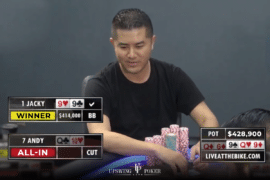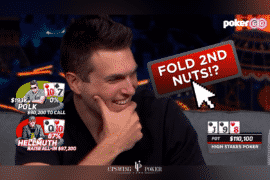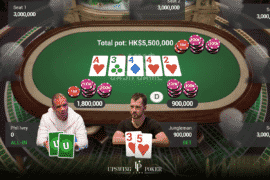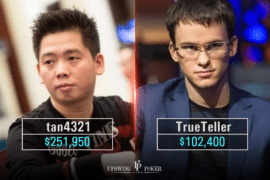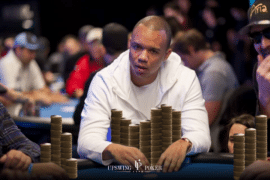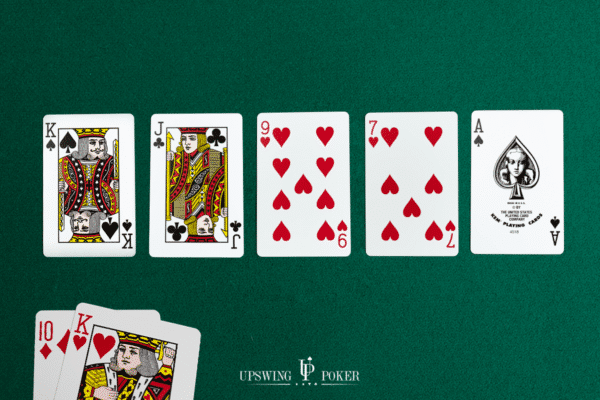
Should He Call 3 Expensive Barrels With Middle Pair? (Analysis)
When you play poker, it can be easy to feel like a one man wolfpack.
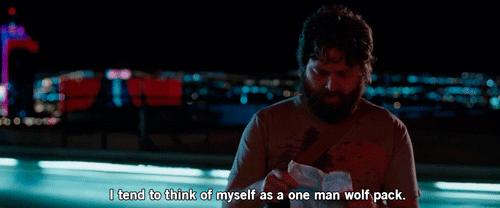
Even if you get along with the people that you are playing with, at the end of the day, you are still competing against them for money. Table camaraderie only goes so far.
That’s why it’s so important to network with other poker players. And one of the most effective ways to do that is to join a discussion group online.
Which leads me to the hand in question today, which was posted in the Upswing Engage group on Facebook…
Members of the Upswing Lab training course get exclusive access to the Engage group, where players of all skill levels discuss poker hands and strategy. With over 4,000 members, 7 coaches, and dozens of new discussions every day, it’s easy to pop in to the group and learn valuable concepts that will help your game.
The Hand
First, let’s take a look at the hand posted by Derek Williams:
$10/$20 Online. 6-handed. $2,060 Effective Stacks.
Preflop: Hero is dealt K♥ T♣ in the small blind.
folds to sb. Hero raises to $60. Big Blind calls.
Flop ($120): K♠ J♣ 9♥
Hero bets $40. Big Blind raises to $120. Hero calls.
Turn ($360): 7♥
Hero checks. Big Blind bets $264. Hero calls.
River ($888): A♠
Hero checks. Big Blind bets $679. Hero…?
Derek had never played against this player before and thus had no reads.
Before moving on to the analysis, vote for the play you think is best in this spot.
Now we’ll go street by street, recapping the discussion between group members (edited for grammar and clarity).
Upswing coach Fried Meulders also weighed in on the hand, and his high-level analysis is included at the end of each section.
Preflop is a pretty trivial raise (though a limping strategy could also be valid), so let’s skip straight to the flop.
Flop
To give your scrolling finger a much deserved rest, I’ll recap the hand before each section of analysis.
$10/$20 Online. 6-handed. $2,060 Effective Stacks.
Preflop: Hero is dealt K♥ T♣ in the small blind.
folds to sb. Derek raises to $60. Big Blind calls.
Flop ($120): K♠ J♣ 9♥
Hero bets $40. Big Blind raises to $120. Hero calls.
Flop Analysis
Long time Lab member Igor G. started the conversation by questioning the c-bet size used on the flop:
I am just a donk, but why are you using a linear betting range on the flop? I don’t think you have range advantage in the middle of your range [to justify using] a small sizing, and with that bet size you are not folding out much. You got some value equity but you are not loving many turns and you open yourself up to getting [raised]… I think you probably want to create a polar strategy here with bigger bet sizing and use this hand [to check] flop.
Igor raises an important question — should Hero use a merged (small) or polarized (large) bet size?
John M. continued the conversation by bringing up Hero’s range advantage on this flop. To emphasize his point, he added an equity graph that demonstrates the range advantage:
Hero has a big range advantage throughout [the ranges], especially in the middle, as he raised preflop and villain just called. You can see it in the equity graph below. Getting raised isn’t so bad, as he has a [gutshot to effective nuts] with top pair good kicker.
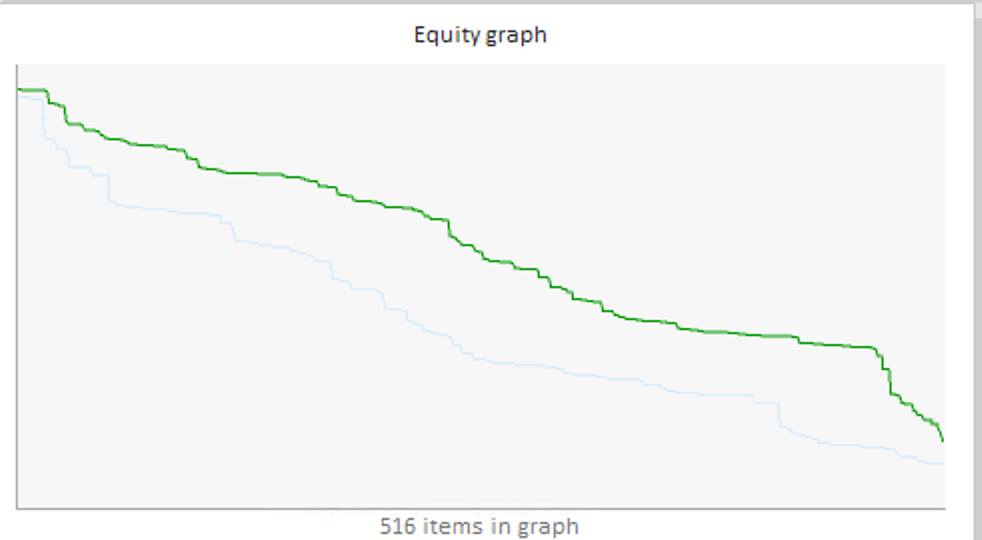
Green line = Hero’s range’s equity, Blue line = Opponent’s range’s equity
Suyash G. furthered this dialogue by running a PioSolver sim and sharing the results to the group:
Yeah, but this texture is quite neutral in the sense that [the in position player] has practically every two pair and straight. But given his overall range we are still at an decent equity advantage (58% to 42%). And as I already pointed out [in a previous comment], he has a lot of auto-folds in his range (all his suited connectors and offsuit Ax). Just to confirm my intuition, I ran the sim again:
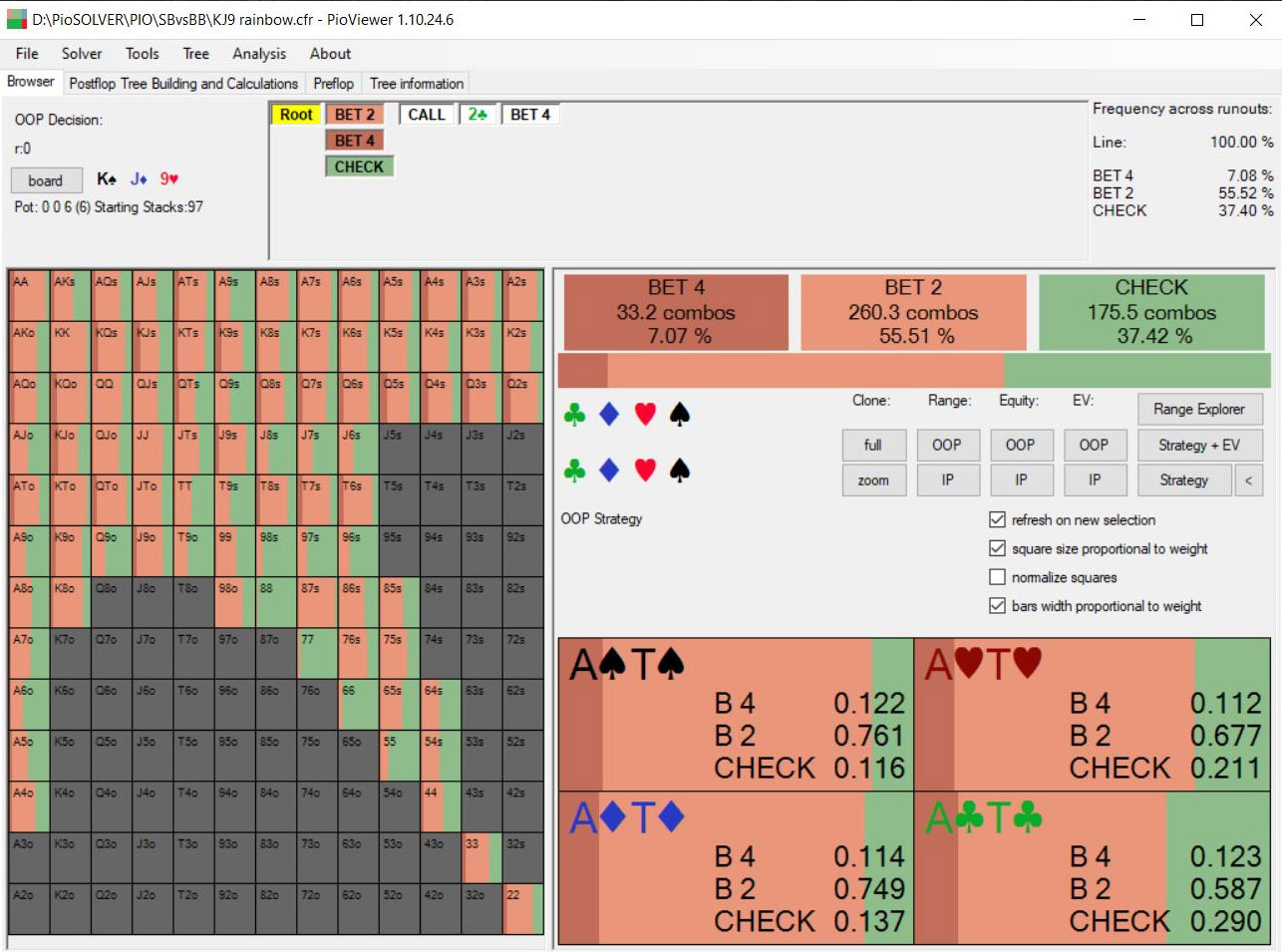
Suyash’s PioSolver solution preferred the smaller size (33% pot) to the bigger size (66% pot)
Finally, Upswing Coach Fried Meulders weighed in with his advice:
Flop is a high frequency small c-bet board for me.
Exact percentage will depend on your ranges and game tree. Bigger size might get used by a solver if you give it the option, but I don’t think it drives any EV — [or at least] you can capture the same EV with just a small size. It’s blind vs blind and ranges are wide. KT is a very strong hand [on the flop].
Villain raises small. I’m expecting no KK or JJ, of course, but some 99 (some BB will have 0% 99 here after flatting, some up to 100%), two-pair, QT, bluffs with Qx/Tx & T8, but also hands like KQ/KT.
In other words, Fried likes the c-bet size used on the flop and doesn’t think the inclusion of a bigger size adds much value.
He goes on to estimate the opponent’s raising range on the flop as: two pair (KJ, K9, J9), straights (QT), straight draws (T8, Qx, Tx), and thin value raises (KT, KQ). Additionally, some players can have 99 here (though some will have 3-bet it out of their range preflop).
Note: Learn step-by-step how to become the best player at the table when you join the Upswing Lab training course. Elite pros have been adding new content every week for the past four years, and you get all of it when you join. Learn more now!
Turn
$10/$20 Online. 6-handed. $2,060 Effective Stacks.
Preflop: Hero is dealt K♥ T♣ in the small blind.
folds to sb. Hero raises to $60. Big Blind calls.
Flop ($120): K♠ J♣ 9♥
Hero bets $40. Big Blind raises to $120. Hero calls.
Turn ($360): 7♥
Hero checks. Big Blind bets $264. Hero calls.
Turn Analysis
David C. weighed in by offering some contrarian advice. He was the only member that suggested folding on the turn:
You’re blocking those hands but what hands can he be [raising] here with? Lots of value combos left even with your blockers and not too many bluffs. I would fold turn.
This would certainly be a tight fold with a double gutshot straight draw and top pair. At low stakes, where players tend to be weak bluffers, folding would make more sense and may even be the preferred play. Against a regular in a $10/$20 game, however, it’s risky to make such tight folds without more reliable information.
Here’s Fried Meulders’ thoughts on the turn:
[The turn] improves villain’s T8 he might raise on the flop. [I’d expect him to] barrel with two-pair+, but KQ/KT can also still fire this turn and check back brick rivers.
Turn bluffs: villain should pick the higher equity hands. Tx is now a double gutter, so that’s preferred as a barrel hand over Qx. Tx/Qx with a flush draw likes to bet.
In general, the consensus was that Hero should call on the turn. Folding would have been too tight, and raising would not have accomplished much as he would fold out hos opponent’s bluffs while only getting called by hands that had him beat.
River
$10/$20 Online. 6-handed. $2,060 Effective Stacks.
Preflop: Hero is dealt K♥ T♣ in the small blind.
folds to sb. Hero raises to $60. Big Blind calls.
Flop ($120): K♠ J♣ 9♥
Hero bets $40. Big Blind raises to $120. Hero calls.
Turn ($360): 7♥
Hero checks. Big Blind bets $264. Hero calls.
River ($888): A♠
Hero checks. Big Blind bets $679. Hero…?
River Analysis
After the backdoor flush draw misses on the river, Hero is in an interesting spot facing a bet. He has second pair with a blocker to the straight, which makes his hand a relatively good bluff-catcher. To quote Chris A.:
This does seem like one of our best bluff catches, and villain doesn’t have that much value, given that most villains are 3-betting [KK, JJ and 99 preflop], and some KJs. Certainly feels like we’re supposed to pay off villain here.
Xavier C echoed these same sentiments, adding that it should be a call some of the time, but not necessarily every time:
You absolutely should hero call this river some of the time. The question is with what frequency. Feel like villain’s line can just as easily be suited Ax of hearts. I’d drop the frequency of your river calls slightly if you didn’t hold at least one heart. Though as you mention the KT has nice blocker effects already.
Finally, Upswing Coach Fried Meulders weighed in by giving a detailed analysis of the spot:
The Ace gives [Hero] some hands that now beat BB’s two-pairs. I don’t think BB should value bet with anything worse than a straight at this point (expect for 99 if he had that preflop).
For that reason I also think he should just jam as his bet size. But for this size, I suppose it’s possible villain does bet KJ for value.
If you’re up against a range of {99, QT/T8 and bluffs with a T or a Q}, T9 is a better bluff catcher than KT. But that only works with perfect information on villain’s betting range.
When there’s some uncertainty, hands like AK or KT are better calls because villain might be betting KJ on the river. AK is a clear call, KT is a decent bluff catcher.
On the river you end up with a couple of strict bluff catchers that all get called at some percentage: KQ, KT, JT, J9… Not really possible to know while playing with which frequency they should be called.
But of all of those, KT seems likes the best bluff catcher intuitively. Blocking the T is more important than blocking a Q and it also blocks some extra value if villain bets KJ. So starting by calling 100% of KT seems good to me.
(If you’re confused about blocking both value and bluffs, check out this video — I discuss this around 26 mins in.)
As Fried explained, the Ten was a powerful card here because holding one made it less likely that Villain had either QT or T8 for a straight.
In addition to this, because Villain only called preflop, it was unlikely that he had any sets, except for maybe 99. KJ and K9 were both possibilities, but were less likely because our Hero had one of the three remaining Kings.
Finally, at $10/$20 online, it is reasonable to assume that most opponents will be capable of following through with bluffs on the river, at least some of the time.
After discussing all of these factors, most members and Fried agreed that our Hero should be calling on this river.
Related reading: Boost Your Winnings by Using Blockers in These 3 Common Spots.
Conclusion and Results
Derek decided to make the call, and he was rewarded with a $2,246 pot. His opponent was bluffing with Q♥ 8♥ for a missed straight draw that turned (and missed) a flush draw.
As you saw in the comments, good players often disagree with exactly how to play a specific hand. Disagreement leads to discussion, which ultimately leads to learning.
Being a part of this group has done wonders for my game, as I am constantly learning about the thought process that other players use at the table. This really demonstrates how valuable poker groups can be.
Want more valuable discussions from Upswing’s members-only group? Read 10 Must-See Poker Discussions from Upswing Engage.
That’s it for today! Good luck at the tables, and make sure that you are always growing your poker network.
Note: The Lab is Upswing’s most popular course, and the elite Lab pros have been adding new content every week for the past 4 years. You get access to all of it when you join. Learn more now!



